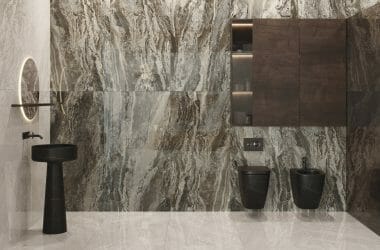Often referred to as a timeless style, herringbone has been lending itself to walls or floor spaces for what feels like forever, and it’s easy to see why. It’s such a beautiful style to go for, creating stand-out pieces and transforming rooms from mediocre to mesmerising.
So, if you want to work some magic on a kitchen or bathroom wall or create a stunning floor finish, it’s worth considering herringbone. But where do you start?
Tile colour and pattern
Your essential first step with any tiling project is deciding on your colour scheme. And this will often depend on the colours already in use within the room.
If your kitchen fit-out boasts a modern, futuristic look with striking coloured units such as red or deep blue, you may prefer a quieter shade for your tiles – whites, light greys, or something natural that blends into the room.
Alternatively, if you have a classic-style kitchen with a quieter colour scheme, then herringbone tiling is a perfect opportunity to make a statement with vibrant colours across your splashbacks.
For some extra wow to an already stylish finish, how about adopting a colour combination for your herringbone? Or you might prefer to use a tile with a grain effect to add some texture to your floor or wall.
Tile shape and size
Most herringbone effects on walls are created using rectangle-shaped tiles. Be aware, though, rectangular tiles come in multiple sizes, and the dimensions you choose will impact the final design.
Thin tiles – those with a longer length to width ratio – provide a dramatic finish, whereas those with a greater width create a more subdued look. Consider the space you’re covering – is it a small area, or do you have plenty of metres to play with?
Herringbone tile layout
Next up, choosing how to arrange your tiles to create the precise herringbone effect you’re after.
Classic herringbone is the perfect option if you’re looking to achieve a more traditional finish with your herringbone tiling. With each tile flipped to a 90˚ angle, then tilted slightly, the finished look is a series of ‘zig-zag’ style arrows pointing north or south, depending on which way the eye naturally follows.
Straight (90˚) herringbone sees your tiles running parallel to one another, creating more of a look akin to a set of steps. Your finished piece is geometric, still creating the same points or arrows achieved through a classic herringbone style only flipped on their side. It’s a modern approach to herringbone and rather striking, particularly when adopting multiple colours.
Stacked herringbone takes things up another notch, with a finish that’s similar to classic herringbone and yet presenting a pattern where your arrows point east or west. This is a fantastic finish, particularly when combined with a contrasting tile layout on an adjacent wall.
Not sure which will work best for your wall space? Put simply, if it’s the timeless look you want, then choose classic. For a contemporary look, go straight. For a talking point, throw some stacked into the mix.
Herringbone tile flooring
Herringbone floors never fail to impress, stopping people in their tracks to admire the design, craftsmanship and care taken to create such a stunning finish. It’s an ageless look, guaranteed to uplift any room and bring a sense of comfort to your home.
Many considerations remain the same whether you’re tiling a wall or floor – choosing your layout, colour schemes and sizing. But for a floor, you also need to give some thought to your materials, with wood, ceramic and porcelain tiles all great options in the right circumstances.
Natural wood has a genuine warmth to it, but it can be difficult to maintain its impressive appearance and it requires optimum care. Plus, being natural, it comes at a premium.
A porcelain wood-effect tile presents an equally fine-looking finish and is much easier to look after. It’s also the more sustainable of the two in rooms where water and steam are a regular feature.
Ceramic tiles are cost-effective although if it’s a bathroom or kitchen you’re tiling, consider purchasing glazed ceramic to provide resistance against water.
Stone or porcelain tiles are a practical choice, particularly for bathrooms and kitchens. They are hard wearing, easy to clean and waterproof. Plus, they come in a range of colours and finishes and look fantastic.
As with any interior renovation project, always spend time researching the market and apply plenty of due diligence before you make a start to prevent any headaches later!
Want to see some of our porcelain tiles? Click here to see out the complete range!


